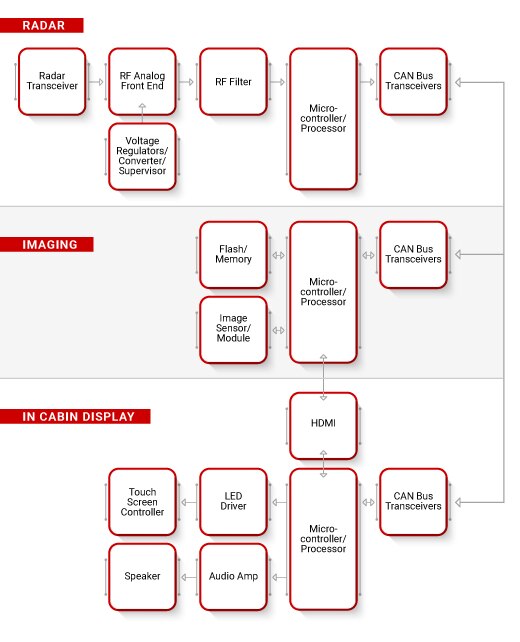Products in the audio amplifier integrated circuit (IC) family are designed specifically for replicating signal-level audio content at increased power levels sufficient to drive headphones, speakers, or similar transducers. Features such as mute inputs, volume controls, and anti-transient (depop) functions distinguish them from general purpose amplifiers. Audio amplifier classes of all types are included such as devices based on Class A, Class D, Class G topologies and others, as well as devices that integrate additional functionality such as analog-to-digital conversion in addition to the amplification function.
Logic buffers, drivers, receivers and transceivers allow isolated access to logic signals from one circuit for use in another circuit. Buffers pass their input signal, either unchanged or inverted, to their output and may be used to clean up a weak signal or drive a load. In a boolean logic simulator, a buffer is mainly used to increase propagation delay. Logic receivers and transceivers allow isolated communication between data buses.
An integrated circuit (IC) semiconductor device designed to process video and/or audio signals in applications such as amplification, enhancement, coders and decoders (codecs), buffering, calibration, processing, signal conditioning, modulation and demodulation, conversion, transmission, gamma correction, switching, OSD, digitizing, and multiplexing.
Devices in the LED driver PMIC (Power Management Integrated Circuit) family are used to supply a current flow of controlled value to a load, typically a Light Emitting Diode, from a power source having a nominally fixed voltage. Key differentiators from the very similar products designed for voltage regulation include a characteristically lower feedback voltage (to improve system efficiency) and high prevalence of provisions for external control of the device's operating point, used to implement dimming functions in lighting applications.
Memory is a semiconductor device that is used as data storage device on an integrated circuit. These devices are available in several formats CBRAM, DRAM, EEPROM, EERAM, EPROM, Flash, FRAM, NVSRAM, PCM (PRAM), PSRAM, RAM, and SRAM in either Non-Volatile or Volatile. These devices memory sizes range from 64 b to 6 Tb with the interface being I2C, MMC, Parallel, eMMC, Serial, Single Wire, SPI, UFS, Xccela Bus, and 1-Wire.
Products in the modular embedded processor family integrate a microcontroller, microprocessor, digital signal processor, FPGA, or other such computational device together with support components such as memory, power management, timing, and other items necessary for their operation. They are suitable and intended for integration into an end product, and offer product developers access to modern computational and interface capabilities without necessity of high speed hardware design experience.
RF Transceiver ICs are semiconductor devices that consist of a transmitter and a receiver in a single package. Transceivers are designed to function proficiently within an RF family or standard such as AISG, Bluetooth, ISM, VHF, Wi-Fi, cellular, RADAR, 802.15.4 and Z-Wave. They are further classified by the type of modulation and the specific protocol versions. Some ICs include a built-in microcontroller.
Products in this family are integrated circuits that integrate one or more of the functions commonly found in the portion of a radio frequency (RF) signal chain that is connected to the system's antenna, such as a low-noise amplifier (LNA) and programmable amplifier (PA). The actual functionality incorporated into any given device varies, with devices targeting relatively narrow applications typically integrating a larger portion of the requisite signal chain than those intended to be more flexible in their application.
Radio frequency filter products provide a frequency-dependent level of signal attenuation, and are distinguished from similar products by their intended use in radio-related applications. They are commonly used to limit the amount of interference caused by strong signals outside a frequency range of interest. Component-level products designed to be incorporated into an electronic assembly as well as modular, connectorized products for lab & test equipment use are both included.
Speaker products are audio frequency electromagnetic transducers used primarily to turn energy in the format of an electrical signal into mechanical compression waves travelling through an atmospheric air environment for reproduction of speech, music, or similar material. Products designed for general purpose reproduction of partial regions of the human audible frequency range (subwoofers, woofers, tweeters, etc.) are included, as well as full range products and special purpose transducers tailored for headset or in-ear applications.
Touch screen controllers are integrated circuits that provide an interface between the touch screen sensor array and the device the screen operates. The controller receives position information from the sensor array which is usually resistive or capacitive. In turn, the position information is passed along to a microcontroller via a serial, parallel, USB, or UART interface.
Products in the DC-DC switching regulator PMIC (Power Management Integrated Circuit) family are component-level devices used in applications requiring stabilization of a DC input voltage and/or transformation thereof to an output voltage of different magnitude. They are distinguished from similar products called "controller" PMICs by virtue of integrating the main switching element through which the power delivered by the device passes.









